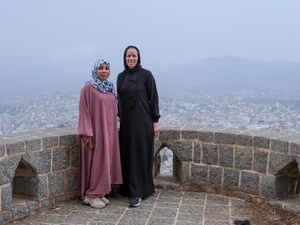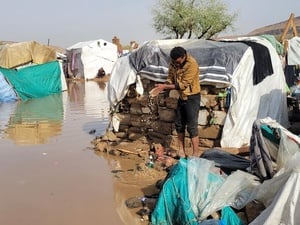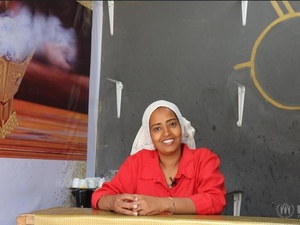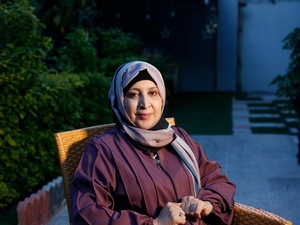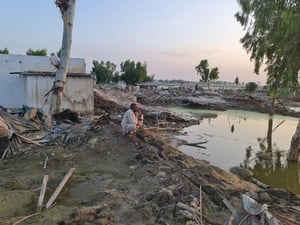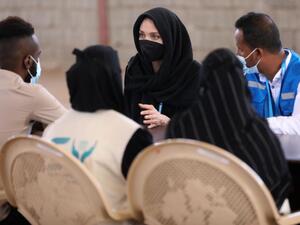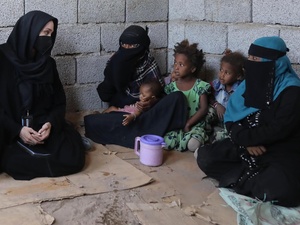Refugee shelters in Yemen damaged during heavy rains
Refugee shelters in Yemen damaged during heavy rains

Storm-hit shelters at Al Kharaz refugee camp in southern Yemen.
AL KHARAZ, Yemen, September 11 (UNHCR) - Heavy windstorms and unusually strong downpours have drenched Al Kharaz refugee camp in southern Yemen, seriously damaging hundreds of shelters and leaving over a thousand people without adequate cover during the stormy season.
Al Kharaz camp was gripped by a driving dust storm on September 1 that tore apart tents used by some refugees in the camp. The worst was to follow, as high winds then drove thunderclouds into the parched area, causing a downpour to sweep across the camp. The heavy rains were more than the corrugated iron roofs and supporting beams in many homes could bear, as 15 cm of sudden rainfall seriously damaged more than 500 shelters in the camp.
UNHCR staff based in Aden report that 300 refugee homes were ruined, leaving over a thousand refugees desperately trying to salvage their drenched food stocks and meagre personal effects left at the mercy of the elements. Another 200 shelters will require less serious repairs.
No one was injured in the storm, which has sent more rain across the region in the following days.
Al Kharaz shelters some 10,000 mainly Somali and Ethiopian refugees. The camp was built over 2000-2001 following an agreement by the UN refugee agency and the government to close the Al Gahin site that had been their temporary home when they were hastily evacuated from Aden in 1994 in the midst of a civil war. Al Kharaz, in a valley west of Aden, is meant to be a more stable home for the thousands of African refugees sheltered there.
UNHCR estimates that an additional $50,000 will be needed to purchase wood and roofing material for the storm-hit Al Kharaz, money not immediately available. The additional needs caused by the rains will further strain the refugee agency's needs. The agency's total budget for Yemen is $3.3 million, but only $1.9 million is available to meet long-foreseen expenses.
Unless fresh contributions for Yemen's refugees arrive, the remaining requirements will have to be covered by UNHCR's over-stretched annual budget, which is facing a shortfall of $100 million.
"We're always tight of funds," said Nabil Mussa, UNHCR's head of sub-office in Yemen. "We only have 166 tents in stock. This is not appropriate for an operation where you can expect emergencies and new arrivals."
The agency has also asked the UN World Food Programme to distribute fresh rations to refugees who saw their food stocks spoiled in the rainstorms.
The rainwater at Al Kharaz refused to soak into the long-parched ground for days, flooding toilets and leaving large pools containing human waste throughout the camp, creating possible breeding grounds for disease and mosquitoes. UNHCR and partner agency workers quickly alerted the refugees to possible sanitary problems resulting from the floods, and they were encouraged to bank sand around the latrines to prevent illness and hygiene problems.
UN High Commissioner for Refugees Ruud Lubbers plans to visit Al Kharaz camp to see for himself the damage caused by the storms during his planned visit to Yemen, set for mid-October.
Yemen's government estimates that the country receives 10,000 Somali refugees every year. The Somalis, mainly hailing from Mogadishu and other towns in the south of their embattled homeland, travel across the often stormy Gulf of Aden in hired boats. Their flight to safety is a trip that can result in death for the desperate people often travelling aboard unseaworthy vessels manned by brutal sailors who sometimes force people into the sea at gunpoint.
Yemen has the Arabian peninsula's largest non-Palestinian refugee population. UNHCR estimates that there are more than 69,000 refugees in the country, though the government puts the figure at more than 165,000 people. The vast majority are Somalis, but 11 other nationalities are also present among the refugee population. Yemen grants prima facie refugee status to all Somali refugees.
In a joint effort, UNHCR and the government of Yemen have begun a landmark initiative to grant identification cards to all refugees. The project was spearheaded in Sana'a, where more than 17,300 refugees received identity papers. It will start by the end of September in Aden and the surrounding region.
Most of Yemen's refugees live in urban areas, where they are self-supporting. In addition to the Al Kharaz refugee camp, UNHCR operates a reception centre for new arrivals east of Aden at Mayfa'a.



